Financial Management Assessment I
Added on 2022-11-28
34 Pages6885 Words365 Views
T-1.8.1
Details of Assessment
Term and Year 2,2019 Time allowed 7Weeks
Assessment No 1 Assessment Weighting 100%
Assessment Type Portfolio of
Due Date Week 7 Room TBA
Details of Subject
Qualification BSB61218 Advanced Diploma of Program Management
Subject Name Financial Management
Details of Unit(s) of competency
Unit Code (s) and
Names
BSBFIM601 Manage finances
Details of Student
Student Name
College Student ID
Student Declaration: I declare that the work
submitted is my own, and has not been
copied or plagiarised from any person or
source.
Signature: ___________________________
Date: _______/________/_______________
Details of Assessor
Assessor’s Name
Assessment Outcome
Results Competent Not Yet Competent Marks / 100
FEEDBACK TO STUDENT
Progressive feedback to students, identifying gaps in competency and comments on positive improvements:
______________________________________________________________________________________
______________________________________________________________________________________
______________________________________________________________________________________
______________________________________________________________________________________
Student Declaration: I declare that I have been
assessed in this unit, and I have been advised of my
result. I am also aware of my right to appeal and the
reassessment procedure.
Signature: ____________________________
Date: ____/_____/_____
Assessor Declaration: I declare that I have
conducted a fair, valid, reliable and flexible
assessment with this student, and I have provided
appropriate feedback
Student did not attend the feedback session.
Feedback provided on assessment.
Signature: ____________________________
Date: ____/_____/_____
Financial Management, Assessment I Page 1
Details of Assessment
Term and Year 2,2019 Time allowed 7Weeks
Assessment No 1 Assessment Weighting 100%
Assessment Type Portfolio of
Due Date Week 7 Room TBA
Details of Subject
Qualification BSB61218 Advanced Diploma of Program Management
Subject Name Financial Management
Details of Unit(s) of competency
Unit Code (s) and
Names
BSBFIM601 Manage finances
Details of Student
Student Name
College Student ID
Student Declaration: I declare that the work
submitted is my own, and has not been
copied or plagiarised from any person or
source.
Signature: ___________________________
Date: _______/________/_______________
Details of Assessor
Assessor’s Name
Assessment Outcome
Results Competent Not Yet Competent Marks / 100
FEEDBACK TO STUDENT
Progressive feedback to students, identifying gaps in competency and comments on positive improvements:
______________________________________________________________________________________
______________________________________________________________________________________
______________________________________________________________________________________
______________________________________________________________________________________
Student Declaration: I declare that I have been
assessed in this unit, and I have been advised of my
result. I am also aware of my right to appeal and the
reassessment procedure.
Signature: ____________________________
Date: ____/_____/_____
Assessor Declaration: I declare that I have
conducted a fair, valid, reliable and flexible
assessment with this student, and I have provided
appropriate feedback
Student did not attend the feedback session.
Feedback provided on assessment.
Signature: ____________________________
Date: ____/_____/_____
Financial Management, Assessment I Page 1
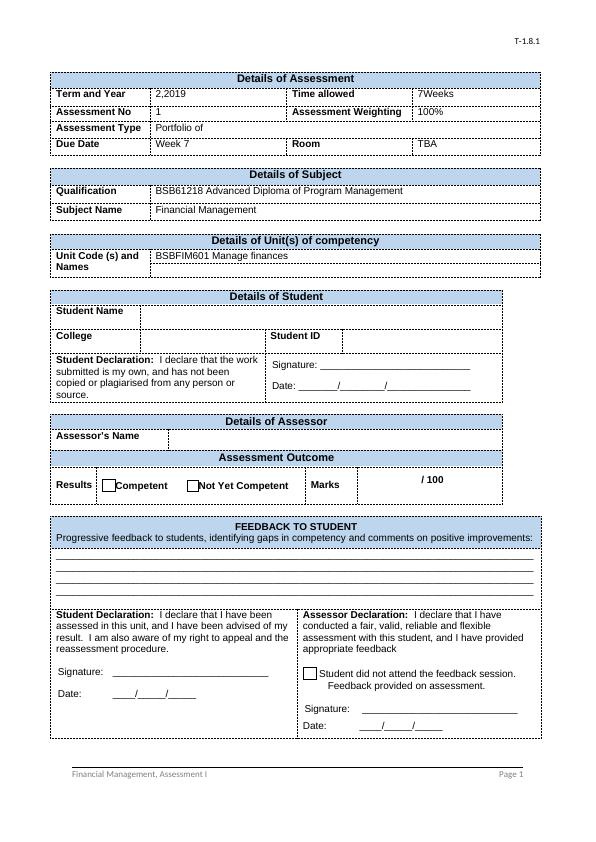
T-1.8.1
Purpose of the Assessment
The purpose of this assessment is to assess the student in the following
learning outcomes:
Competent
(C)
Not Yet
Competent
(NYC)
1.1 Review and analyse previousfinancial data to establish areas which have
generated a profit or loss
1.2 Undertake research to review reasons for previous profit and loss
1.3 Review business plan to establish critical dates and initiatives that will
require or generate resources in the next financial cycle
1.4 Analyse cash flow trends
1.5 Review statutory requirements for compliance and liabilities for tax
1.6 Review existing software and its suitability for financial management
2.1 Use previous financial data to determine allocations for resources
2.2 Make informed estimates of new items for inclusion in budget
2.3 Prepare budgets in accordance withorganisational requirements and
statutory requirements
3.1 Circulate budgets and ensure managers and supervisors are clear about
budgets, reporting requirements and financial delegations
3.2 Manage risks by checking there are no opportunities for misappropriation of
funds and that systems are in place to properly record all financial transactions
3.3 Review profit and loss statements, cash flows and ageing summaries
3.4 Revise budgets, as required, to deal with contingencies
3.5 Maintain audit trails to ensure accurate tracking and to
identifydiscrepanciesbetween agreed and actual allocations
3.6 Ensure compliance with due diligence
4.1 Ensure structure andformat of reports are clear and conform to
organisational and statutory requirements
4.2 Identify and prioritise significant issuesin statements, including comparative
financial performances for review and decision making
4.3 Preparerecommendations to ensure financial viability of the organisation
4.4 Evaluate the effectiveness of financial management processes
Assessment/evidence gathering conditions
Each assessment component is recorded as either Competent (C) or Not Yet Competent (NYC). A student
can only achieve competence when all assessment components listed under “Purpose of the assessment”
section are recorded as competent. Your trainer will give you feedback after the completion of each
assessment. A student who is assessed as NYC (Not Yet Competent) is eligible for re-assessment.
Resources required for this Assessment
Computer with relevant software applications, access to internet and weekly eLearning notes
Instructions for Students
Please read the following instructions carefully
This assessment has to be completed In class At home
The assessment is to be completed according to the instructions given by your assessor.
Feedback on each task will be provided to enable you to determine how your work could be improved.
You will be provided with feedback on your work within two weeks of the assessment due date. All other
feedback will be provided by the end of the term.
Should you not answer the questions correctly, you will be given feedback on the results and your gaps
in knowledge. You will be given another opportunity to demonstrate your knowledge and skills to be
deemed competent for this unit of competency.
If you are not sure about any aspects of the assessment, please ask for clarification from your assessor.
Please refer to the College re-assessment for more information (Student Handbook).
Financial Management, Assessment I Page 2
Purpose of the Assessment
The purpose of this assessment is to assess the student in the following
learning outcomes:
Competent
(C)
Not Yet
Competent
(NYC)
1.1 Review and analyse previousfinancial data to establish areas which have
generated a profit or loss
1.2 Undertake research to review reasons for previous profit and loss
1.3 Review business plan to establish critical dates and initiatives that will
require or generate resources in the next financial cycle
1.4 Analyse cash flow trends
1.5 Review statutory requirements for compliance and liabilities for tax
1.6 Review existing software and its suitability for financial management
2.1 Use previous financial data to determine allocations for resources
2.2 Make informed estimates of new items for inclusion in budget
2.3 Prepare budgets in accordance withorganisational requirements and
statutory requirements
3.1 Circulate budgets and ensure managers and supervisors are clear about
budgets, reporting requirements and financial delegations
3.2 Manage risks by checking there are no opportunities for misappropriation of
funds and that systems are in place to properly record all financial transactions
3.3 Review profit and loss statements, cash flows and ageing summaries
3.4 Revise budgets, as required, to deal with contingencies
3.5 Maintain audit trails to ensure accurate tracking and to
identifydiscrepanciesbetween agreed and actual allocations
3.6 Ensure compliance with due diligence
4.1 Ensure structure andformat of reports are clear and conform to
organisational and statutory requirements
4.2 Identify and prioritise significant issuesin statements, including comparative
financial performances for review and decision making
4.3 Preparerecommendations to ensure financial viability of the organisation
4.4 Evaluate the effectiveness of financial management processes
Assessment/evidence gathering conditions
Each assessment component is recorded as either Competent (C) or Not Yet Competent (NYC). A student
can only achieve competence when all assessment components listed under “Purpose of the assessment”
section are recorded as competent. Your trainer will give you feedback after the completion of each
assessment. A student who is assessed as NYC (Not Yet Competent) is eligible for re-assessment.
Resources required for this Assessment
Computer with relevant software applications, access to internet and weekly eLearning notes
Instructions for Students
Please read the following instructions carefully
This assessment has to be completed In class At home
The assessment is to be completed according to the instructions given by your assessor.
Feedback on each task will be provided to enable you to determine how your work could be improved.
You will be provided with feedback on your work within two weeks of the assessment due date. All other
feedback will be provided by the end of the term.
Should you not answer the questions correctly, you will be given feedback on the results and your gaps
in knowledge. You will be given another opportunity to demonstrate your knowledge and skills to be
deemed competent for this unit of competency.
If you are not sure about any aspects of the assessment, please ask for clarification from your assessor.
Please refer to the College re-assessment for more information (Student Handbook).
Financial Management, Assessment I Page 2
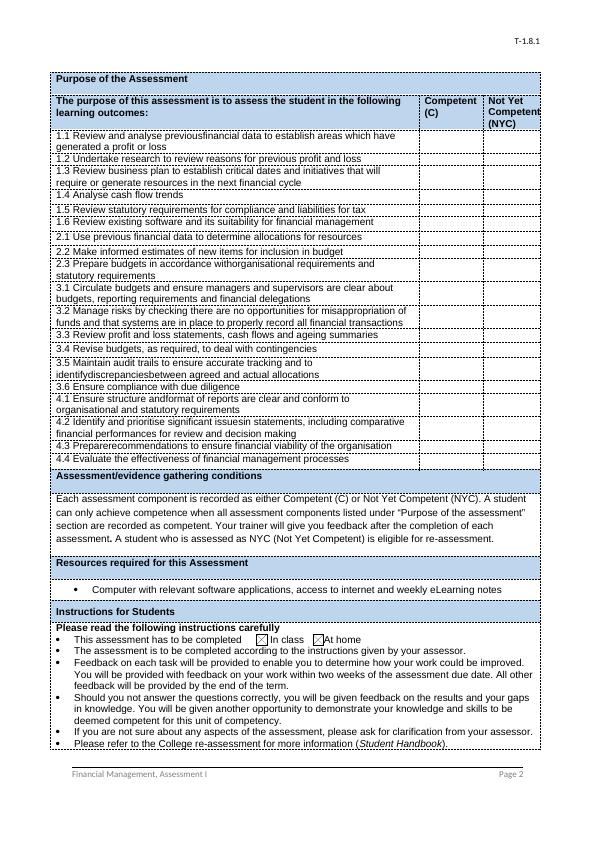
T-1.8.1
ASSESSMENT BRIEF
In this assessment task, you will use your skills and knowledge to undertake budgeting,
financial forecasting and reporting and to allocate and manage resources to achieve the
required outputs for the business unit. You work willalso include contributing to financial bids
and estimates, allocating funds, managing budgets and reporting on financial activity.
The assessment is divided into three parts and weight allocations as below:
PART A: WRITTEN REPONSES – 25%
PART B: MANAGE FINANCES PROJECT ON A SIMULATED WORK ORGANISATION – 65%
PART C: PRESENTATION OF AUSTRALIAN HARDWARE FINANCIAL ANALYSIS – 10%
Financial Management, Assessment I Page 3
ASSESSMENT BRIEF
In this assessment task, you will use your skills and knowledge to undertake budgeting,
financial forecasting and reporting and to allocate and manage resources to achieve the
required outputs for the business unit. You work willalso include contributing to financial bids
and estimates, allocating funds, managing budgets and reporting on financial activity.
The assessment is divided into three parts and weight allocations as below:
PART A: WRITTEN REPONSES – 25%
PART B: MANAGE FINANCES PROJECT ON A SIMULATED WORK ORGANISATION – 65%
PART C: PRESENTATION OF AUSTRALIAN HARDWARE FINANCIAL ANALYSIS – 10%
Financial Management, Assessment I Page 3
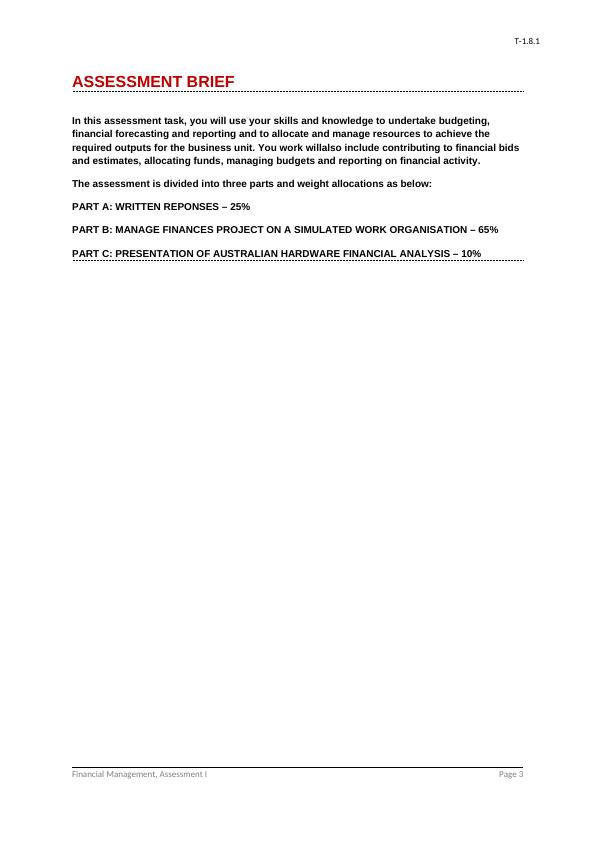
T-1.8.1
PART A: WRITTEN REPONSES – 25%
Instructions: Thispart of the assessment comprises the knowledge testing required for the unit
BSBFIM601. Thispart includes 8 questions and you must respond to all. Use the spaces below to
respond to the questions. Weights and marking allocations are in the marking allocating table.
Question 1. Planning for financial management. (2 marks)
Explain why it is necessary for all business organisations to have effective financial
management systems and explaining how the information held in financial management
systems contribute to ongoing business performance and business planning.
Financial management is a practice that is about to manage the financial resources
associated with the business entity and establishes a proper control over the utilisation of the
financial resources part of the organisation. Financial management involve financial
planning, implementation, monitoring and control over the utilisation of the financial
resources part of the company. This is a process that involves managing the financial
resources associated with the company in such way that company get to achieve the best level
of business objectives. Every company require financial resources to ensure the best level of
utility against the financial resources hold by the business entity. Every single function and
operation activity part of the company seek financial resources especially related to the
implementation stage of the business practices. Business entity needed to ensure the best
level of control and monitoring over the use of the financial resources in the organisation.
Business planning always involves the financial management part that is about to manage the
financial resources associated with the organisation in such way that professionals get
appropriate resources so that company can deliver its business objectives. This is all about
ensuring the proper availability of finances so that company can ensure the proper utility of
the financial resources in the business.
Financial Management, Assessment I Page 4
PART A: WRITTEN REPONSES – 25%
Instructions: Thispart of the assessment comprises the knowledge testing required for the unit
BSBFIM601. Thispart includes 8 questions and you must respond to all. Use the spaces below to
respond to the questions. Weights and marking allocations are in the marking allocating table.
Question 1. Planning for financial management. (2 marks)
Explain why it is necessary for all business organisations to have effective financial
management systems and explaining how the information held in financial management
systems contribute to ongoing business performance and business planning.
Financial management is a practice that is about to manage the financial resources
associated with the business entity and establishes a proper control over the utilisation of the
financial resources part of the organisation. Financial management involve financial
planning, implementation, monitoring and control over the utilisation of the financial
resources part of the company. This is a process that involves managing the financial
resources associated with the company in such way that company get to achieve the best level
of business objectives. Every company require financial resources to ensure the best level of
utility against the financial resources hold by the business entity. Every single function and
operation activity part of the company seek financial resources especially related to the
implementation stage of the business practices. Business entity needed to ensure the best
level of control and monitoring over the use of the financial resources in the organisation.
Business planning always involves the financial management part that is about to manage the
financial resources associated with the organisation in such way that professionals get
appropriate resources so that company can deliver its business objectives. This is all about
ensuring the proper availability of finances so that company can ensure the proper utility of
the financial resources in the business.
Financial Management, Assessment I Page 4
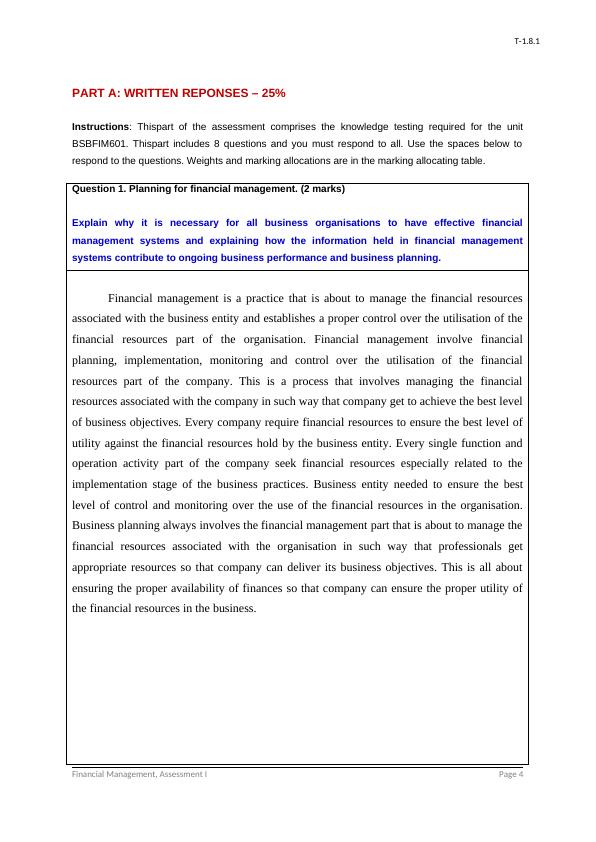
T-1.8.1
Question 2. Establishing budgets and allocated funds. (3 marks)
a) What is a Budget?
b) What data might inform a new budget?
c) How does analysis of previous financial data assist projected resource estimates and
allocations?
a.
Budget is a process used under the financial management practice that is about to
bring out finances so that various functional and operational responsibilities associated with
the business entity could have been meet by the business entity. This is a process that is about
to analysis the possible expenditures require to incur in against to deliver certain functional
responsibilities and to achieve the business objectives in the best way possible. This is a
professional level of practice that involves anticipating the possible expenses for the
upcoming time and on the basis of that prepare the best level of budget to meet up all such
expenses required to fulfil the operation and functional responsibility. This is a process that
involve analysing the possible expenditure and bring out the financial resources for
addressing such a part.
Financial Management, Assessment I Page 5
Question 2. Establishing budgets and allocated funds. (3 marks)
a) What is a Budget?
b) What data might inform a new budget?
c) How does analysis of previous financial data assist projected resource estimates and
allocations?
a.
Budget is a process used under the financial management practice that is about to
bring out finances so that various functional and operational responsibilities associated with
the business entity could have been meet by the business entity. This is a process that is about
to analysis the possible expenditures require to incur in against to deliver certain functional
responsibilities and to achieve the business objectives in the best way possible. This is a
professional level of practice that involves anticipating the possible expenses for the
upcoming time and on the basis of that prepare the best level of budget to meet up all such
expenses required to fulfil the operation and functional responsibility. This is a process that
involve analysing the possible expenditure and bring out the financial resources for
addressing such a part.
Financial Management, Assessment I Page 5
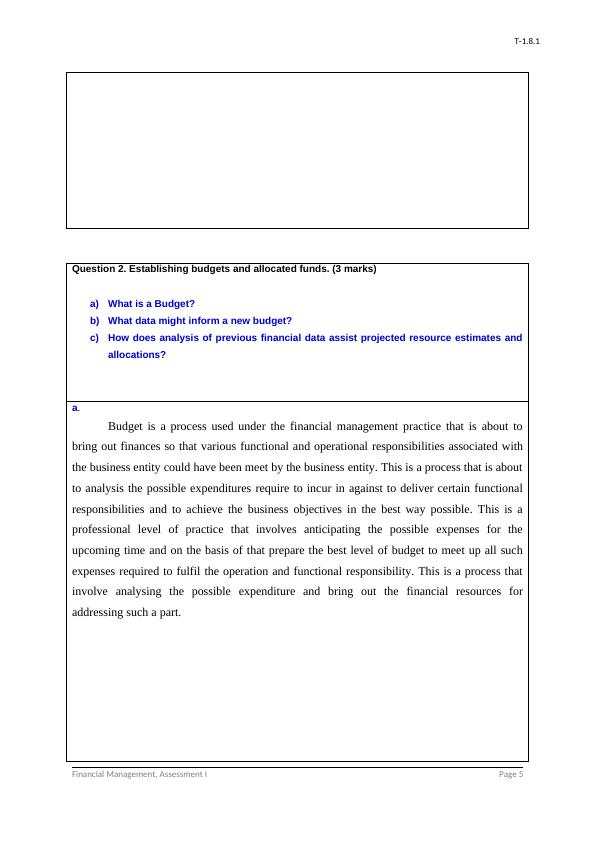
T-1.8.1
b.
Data regarding cost, income, expenditure and such related data are required to address
budget. Costing is an important factor or data that needed to identify by the business entity in
against to deliver the best possible budget. The budget is all prepared on the basis and
information collected and generated. The data and the information become basis of preparing
the budget in the market. Cost and expenditure related to the function or operation is the most
convenient information that is required to prepare the budget. Along with this other
information related to the time of performing the action is also essential to prepare the
budget.
c.
In case of the budget the data and information related to the previous financial years
and time is also very necessary to prepare the best suitable budget. This is all about analysing
the previous expenses so that professional and the finance manager can ascertain about the
future expenses over the same performance. This is an important part of the professional to
prepare the budget in the best way possible. Previous cost allow and guide the professional to
identify the least possible expenses over the same performance and by adding a certain value
to the previous cost company get to prepare the budget. This is important for the professional
to ascertain the previous cost when it comes to prepare the budget for the business operations.
Financial Management, Assessment I Page 6
b.
Data regarding cost, income, expenditure and such related data are required to address
budget. Costing is an important factor or data that needed to identify by the business entity in
against to deliver the best possible budget. The budget is all prepared on the basis and
information collected and generated. The data and the information become basis of preparing
the budget in the market. Cost and expenditure related to the function or operation is the most
convenient information that is required to prepare the budget. Along with this other
information related to the time of performing the action is also essential to prepare the
budget.
c.
In case of the budget the data and information related to the previous financial years
and time is also very necessary to prepare the best suitable budget. This is all about analysing
the previous expenses so that professional and the finance manager can ascertain about the
future expenses over the same performance. This is an important part of the professional to
prepare the budget in the best way possible. Previous cost allow and guide the professional to
identify the least possible expenses over the same performance and by adding a certain value
to the previous cost company get to prepare the budget. This is important for the professional
to ascertain the previous cost when it comes to prepare the budget for the business operations.
Financial Management, Assessment I Page 6

T-1.8.1
Question 3. Implement Budgets. (4 marks)
a) How do profit and loss statements cash flow and using aging summaries contribute to
new budgets?
b) How can you ensure that managers and supervisors in the organisation understand
the budget and understand their reporting requirements with regard to financial
management?
c) Budgets are used to identify and track discrepancies between agreed and actual
allocations. Explain.
d) How do budgets contribute to analysis of existing financial management approaches?
a) When it comes to preparing the budget the profit and loss account and other such
financial records are also consumed. These become a strong basis for the professional
and the finance manager to understand the actual requirements of the business entity.
The budget is immensely influenced with potential cost or expenditure the business
entity incurred. The main aim of the budget is to provide suitable basis to design the
best possible budget that can ensure all financial or the budgetary requirements of the
business entity.
b) In context to the budget management practice the role of the manager and the
professional become very essential. The professionals guide the management about
the right sources and the information that can indicate and guide the professional to
know the exact figure related to cost and spending of the business entity. This makes
the budget more specific in respect to the business entity. The aim of the budget is to
identify the possible cost or the expenditure and bring out financial resources for
delivering such a practice. This become the basis of the organization and professional
for preparing the right budget so that business entity can deliver the operations and
functions in the best way possible.
Financial Management, Assessment I Page 7
Question 3. Implement Budgets. (4 marks)
a) How do profit and loss statements cash flow and using aging summaries contribute to
new budgets?
b) How can you ensure that managers and supervisors in the organisation understand
the budget and understand their reporting requirements with regard to financial
management?
c) Budgets are used to identify and track discrepancies between agreed and actual
allocations. Explain.
d) How do budgets contribute to analysis of existing financial management approaches?
a) When it comes to preparing the budget the profit and loss account and other such
financial records are also consumed. These become a strong basis for the professional
and the finance manager to understand the actual requirements of the business entity.
The budget is immensely influenced with potential cost or expenditure the business
entity incurred. The main aim of the budget is to provide suitable basis to design the
best possible budget that can ensure all financial or the budgetary requirements of the
business entity.
b) In context to the budget management practice the role of the manager and the
professional become very essential. The professionals guide the management about
the right sources and the information that can indicate and guide the professional to
know the exact figure related to cost and spending of the business entity. This makes
the budget more specific in respect to the business entity. The aim of the budget is to
identify the possible cost or the expenditure and bring out financial resources for
delivering such a practice. This become the basis of the organization and professional
for preparing the right budget so that business entity can deliver the operations and
functions in the best way possible.
Financial Management, Assessment I Page 7

T-1.8.1
c) The budget also play the role in anticipating the expenditure of the business entity.
This is all about anticipating the agreed cost and the actual cost. The cost management
is also become a crucial or the significant part of the budget. With support of this
practice company can analysis the cost management practice. The budget is all about
anticipating the potential spending over the functions and operations. This is done
with the previous records and the inflation rate of the economy and based on that
identifies the best possible spending with support of the budget. All this allow the
company to identify the difference between the expected cost and the actual cost.
d) Budget is a practice that drives and guides the business entity to understand about the
spending of the organisation. This practice guide the company to understand the
significance of the financial management approach follow by the company. Budget is
among the most significant part of the financial management practice. This denotes
that how effectively the business entity is capable to deliver its financial management
practice.
Financial Management, Assessment I Page 8
c) The budget also play the role in anticipating the expenditure of the business entity.
This is all about anticipating the agreed cost and the actual cost. The cost management
is also become a crucial or the significant part of the budget. With support of this
practice company can analysis the cost management practice. The budget is all about
anticipating the potential spending over the functions and operations. This is done
with the previous records and the inflation rate of the economy and based on that
identifies the best possible spending with support of the budget. All this allow the
company to identify the difference between the expected cost and the actual cost.
d) Budget is a practice that drives and guides the business entity to understand about the
spending of the organisation. This practice guide the company to understand the
significance of the financial management approach follow by the company. Budget is
among the most significant part of the financial management practice. This denotes
that how effectively the business entity is capable to deliver its financial management
practice.
Financial Management, Assessment I Page 8
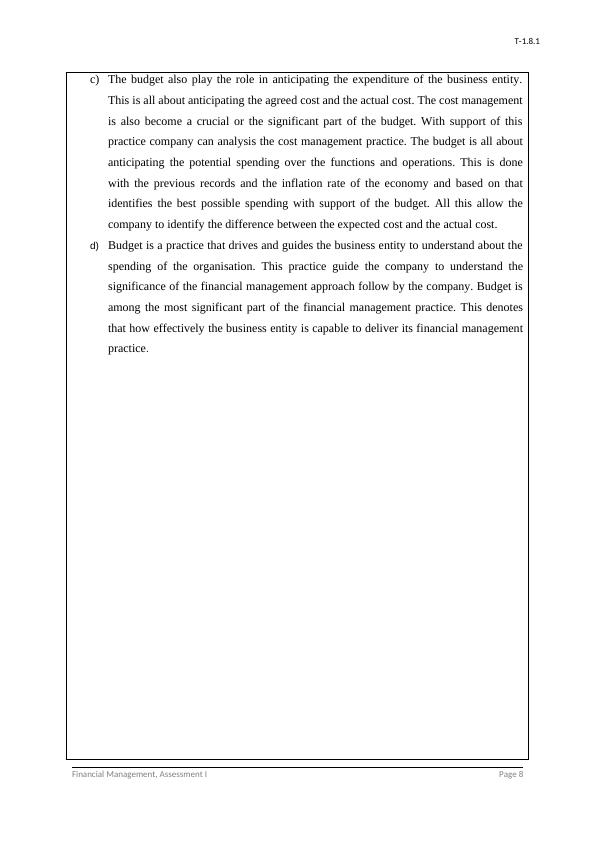
End of preview
Want to access all the pages? Upload your documents or become a member.
Related Documents
Importance of Financial Management Systems in Business Operationslg...
|27
|6780
|49
Financial Management Assessment for BSB61215 Advanced Diploma of Program Managementlg...
|26
|6404
|326
BSB61015 Advanced Diploma in Leadership and Management (doc)lg...
|22
|4778
|21
Circulate budgets and ensure managers and supervisorslg...
|25
|6836
|21
T-1.8.1. Details of Assessment Term and Year. 1, 2019.lg...
|23
|5113
|87
Program Benefits Analysis for XXXlg...
|26
|6198
|22
